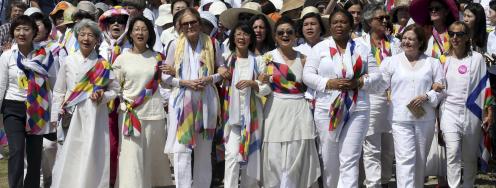Updated: June 15, 2018
On June 12, 2018, the United States and North Korea held a historic summit in Singapore. Both sides signed a joint statement in which President Trump committed to provide security guarantees to North Korea, and Kim Jong Un committed to work toward the “complete denuclearization of the Korean peninsula.” In the press conference to follow, President Trump, responding to questions about what specific assurances he would give to Kim, said “We will be stopping the war games.”
The announcement has reignited a debate about the merits of suspending joint US-Republic of Korea (ROK) military exercises in exchange for concessions from North Korea. According to President Trump, “[U]nder the circumstances that we are negotiating a very comprehensive, complete deal, I think it’s inappropriate to be having war games.” Admiral Harry Harris echoed those remarks at his confirmation hearing to be US ambassador to South Korea, stating, “I think the whole landscape has shifted and I believe that we should give exercises, major exercises, a pause, to see if Kim Jong Un in fact is serious.” Similarly, South Korea’s President Moon expressed a willingness to suspend exercises as part of the country’s need “to flexibly change its military pressure against the North in the spirit of building mutual trust as agreed in the Panmunjom Declaration.”
The Trump administration’s current position marks a shift from its opposition to the “freeze-for-freeze” proposal— or suspension of joint military exercises in exchange for a pause on North Korea’s nuclear and missile testing— one year ago. North Korea has long viewed US-ROK war drills as a threat and precursors to invasion. China and Russia promoted the freeze as one diplomatic option to bring North Korea back to the negotiating table.
The Trump administration initially opposed the proposal on the basis that military exercises are both a necessary deterrent and strictly routine. US Ambassador to the United Nations Nikki Haley called the freeze-for-freeze proposal “insulting.” Likewise, South Korean Ambassador Cho Tae-yul said it would be inappropriate to link defensive exercises with provocations by North Korea.
However, history shows that suspending US-ROK military exercises can be an important factor in a successful diplomatic approach to the North. In 1992, the United States suspended Team Spirit, an annual field exercise involving hundreds of thousands of US-ROK troops. The Bush administration’s decision to suspend the 1992 exercises was a key part of a diplomatic strategy to encourage North Korea to cooperate on nuclear inspections. Team Spirit exercises were suspended again between 1994-1996, after which they were permanently cancelled. (Modified exercises resumed in 1997.)
The suspension of Team Spirit in 1994 was essential for preventing a military conflict with North Korea. Following North Korea’s announcement that it would produce weapons-grade plutonium, the United States was prepared to conduct surgical strikes on North Korea’s nuclear facilities. However, the risks of provoking a North Korean military response compelled the Clinton Administration to find a diplomatic solution.
The United States was able to avert a second Korean War by negotiating the 1994 Agreed Framework. This agreement froze North Korea’s plutonium production for eight years (1994 to 2002), during which time the North could have produced enough plutonium for more than 100 nuclear warheads. Suspending Team Spirit was a moderate, impactful adjustment to US-ROK military exercises that at no time undermined the alliance’s ability to mount an effective defense.
There are many options the Trump administration could consider to scale back or suspend military exercises as it explores negotiations with the North. In fact, the administration has demonstrated flexibility this year. In the spirit of the Winter Olympics in South Korea, the joint military exercises Foal Eagle and Key Resolve, which typically take place in March and involve more than 300,000 US-ROK troops, were postponed, shortened, and devoid of nuclear strategic assets. Foal Eagle is a large-scale Field Training Exercise, or a rehearsal of actual military maneuvers involving ground, air, and naval forces. It runs parallel to Key Resolve, a Command Post Exercise that does not typically involve large-scale field exercises. These exercises include scenarios that assume the deployment of THAAD, a US missile defense system that China has stated “gravely harms the strategic security interests” of countries in the region.
Ulchi Freedom Guardian is another Command Post Exercise that typically occurs in August. Although the exercises are largely computerized, they involve tens of thousands of US-ROK troops. According to one South Korean defense official, the last exercise included “a nuclear war game” for the first time. On June 18, 2018, the US announced the suspension of the Ulchi Freedom Guardian exercise-- "[c]onsistent with President Donald J. Trump's commitment to North Korea and in concert with South Korea."
Absent a peace settlement to formally end the Korean War, the United States and South Korea have been conducting military exercises under the auspices of the 1953 Mutual Defense Treaty. US military officials assert that joint exercises are carried out in the Treaty’s spirit of collective defense, but changes to the US-ROK exercise program’s size, scope, and purpose are consistent with the agreement.
As has happened before, US-ROK military exercises can be adapted to meet diplomatic and security objectives. There are several options that may mitigate tensions and lay the groundwork for dialogue:
- Suspend. The US and South Korea could suspend major military exercises on the peninsula for as long as North Korea refrains from staging nuclear or missile tests. To address concerns that a suspension would compromise combat readiness, modified exercises could be held outside of South Korea.
- Scale down. A special advisor to South Korean President Moon Jae-in has proposed that South Korea “scale down deployment of American strategic weapons over the Korean peninsula” in exchange for a freeze on North Korea’s nuclear and missile activities.
- Redesign. US-ROK exercises could be redesigned to omit provocative scenarios, such as those described in OPLAN 5015. This newly adopted wartime plan includes strikes against nuclear facilities and the top North Korean leadership. So-called “decapitation” raids undermine the administration’s stated policy against regime change and reinforce North Korea’s narrative of US hostility.
- Reassure. Another option is to offer North Korea forms of reassurance during US-ROK exercises. This could include inviting outside observers, such as China and Russia, to monitor the drills.
As history has shown, the adjustment or suspension of military exercises can foster a more favorable environment for dialogue between the United States and North Korea. These options should be considered in light of their past successes, and future prospects, to de-escalate crisis and promote dialogue on the Korean Peninsula.
| US-ROK MILITARY EXERCISES | ||||
| Name | Date | Size Range | Purpose | Notes |
| Team Spirit | 1976-1993 | 100,000 – 200,000 | Field | Suspended in 1992, 1994, 1995, and 1996. |
| Foal Eagle | 2007-Present | 50,000-300,000 | Field | Replaced Team Spirit. |
| Key Resolve | Command | |||
| Ulchi Freedom Guardian | 1976-Present | 70,000-75,000 | Command | Resumes August 2018. |
Contact: Catherine Killough, ckillough@ploughshares.org
US-ROK military exercises can be adapted to meet diplomatic and security objectives.




